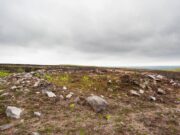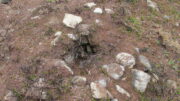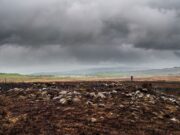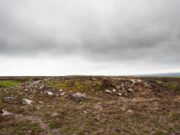Cairn: OS Grid Reference – SE 14233 43987
Also Known as:
- Small Skirtful of Stones

Probably the easiest way to find this is to use other sites as guides. From the Great Skirtful of Stones tomb, get over the fencing and follow it eastwards for exactly 500m (238 yards) where you’ll meet a small footpath on your right that goes southeast up the small slope of Craven Hall Hill and onto the moorland. Go along here for literally 0.2km (223 yards) and, just where the path bends slightly to the left, drop diagonally down the slope to where the moorland levels out close to the Craven Hall Hill (2) tumulus. From here walk WSW onto the flat moorland for literally ⅓-km (0.21 miles; 365 yards) where you’ll find either a large rounded mass of stones, or a large heather-covered mound—depending on whether there’s been a burning. Best o’ luck!
Archaeology & History

Very troublesome to locate when the heather’s fully grown, this large prehistoric tomb was uncovered very recently as a result of extensive moorland fires. It’s the largest such structure in a cluster of more than thirty cairns near the middle of Hawksworth Moor, many of which were rediscovered at the end of May, 2021. Due south of the Great Skirtful of Stones, this smaller skirtful of stones measures some 45 feet across and is more than three feet high in parts. Probably built in the Bronze Age, the tomb looks as if it’s been deliberately robbed at some time in the past, probably before the Victorians by the look of things—although only an excavation would tell us for sure. Primarily, the cairn has been robbed from its centre outwards mainly on its western side, where you’ll also see a small and rather dodgy cup-marked stone. Scattered into the surrounding peat are visible remains of where some of the loose stones have been cast.


A possible alternative to this being simply a large cairn, is that it’s a much-disturbed ring cairn. Some sections on the north and western edges give the impression that the mass of stones may be collapsed rubble walling. There are also a couple of internal features beneath the overgrowth of peat and compressed vegetation: one being a small circular piece of stonework that has either fallen in on itself, been dug into, or is the home of an animal; and a yard or two from this is what looks like another internal U-shaped stone structure – again, deeply encased by centuries of encroaching peat. But I must emphasize that these features are far from certain and can only be proven one way or the other by an excavation.


The site is well worth seeing, not only for its own merit, but also because of its place in a much wider prehistoric cemetery in the middle of Hawksworth Moor. There are at least six small single cairns (which may be clearance cairns) scattering this area—the closest of which from here is some 20 yards to the north. A more curious group of at least five small long cairns exist about 100 yards to the south; and below these is the largest cluster of standard tombs in the form of small round cairns. A curious D-shaped hut circle structure can be found less than 100 yards to the northwest, and what seems to be remains of a larger deeply embedded enclosure exists beyond the long cairns. Check ’em out!
Acknowledgements: With huge thanks, as always, for James Elkington for use of his photos. Also to the evolving megalith and landscape explorer Mackenzie Erichs; and to Linzi Mitchell, for additional stimuli…
© Paul Bennett, The Northern Antiquarian
The map could not be loaded. Please contact the site owner.